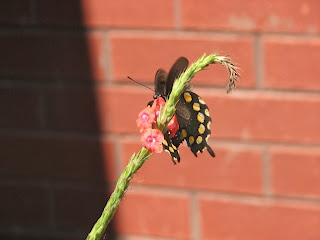On her blog,
Handbook of Nature Study, Barb has posted three different posts about trees, giving us ideas to work through for our nature study this winter. (The other two can be found
here and
here).
Though our winter has been mild compared to the sufferings of those in the NE, we have had the worst/coldest/
iciest winter in about 20 years. This has meant day after day of indoor activities rather than outside time.
I decided that it might be a good idea to take Barb up on the challenges. It would be a good way to get us outside again.
I told the kids that they had two assignments in this walk in the woods. First, I wanted them to find a deciduous tree in wintertime to photograph. And second, I wanted them to find a pine tree to photograph. It was amazing that such a simple challenge could provide such a wonderful opportunity for observation.
We have walked in these woods numerous times. Pine trees are EVERYWHERE around here. They are just part of the background of our lives. But the simple assignment of finding a pine tree helped them with their observation skills in a really new way. At first, I had to ask them, "Do you see a pine tree around here?" They would look around, confusedly. "No," they would shrug as they stood directly beside a pine. Then I showed them the bark, or pine cones on the ground, or pine needles hanging in the surrounding trees.
.jpg) |
| Hmm. Are any pine trees nearby? |
.jpg) |
| Any pine trees in the area? |
Soon the kids were running up the trail, shouting, "Pine! I see a pine tree." It was like a game of "I Spy." And the kids were ecstatic about it.
Before we the walk, I read them a small part from
Handbook of Nature Study where Ms. Comstock explained how the pine tree makes rosin to heal itself from wounds. She explained that this was used to make turpentine.
We actually got to see some of this rosin. Wonderful serendipity!
 |
| See the rosin on the pine tree? It used this to seal its wound. |
My middle daughter gathered pine cones. The next day, we examined them and drew them. We talked about how pine cones use the weather to help them distribute their seeds, using information from
this site. We tried the experiment, but the glue didn't hold, so we couldn't see it scientifically, but we could see with our eyes that the pine cone was closed tighter on a wet, cool morning.
We also found two branches with pine needles attached. We brought them home and compared them. One had darker green coloring and shorter leaves than the other.
We didn't bother to try to learn individual types of pines, but it was a great experience to learn what we did about pine trees.
I am linking up with
.jpg)




.jpg)
.jpg)
.jpg)

.jpg)
.jpg)
.jpg)


.jpg)
.jpg)
.jpg)

.jpg)





.jpg)
.jpg)
.jpg)
.jpg)
.jpg)
.jpg)


.jpg)
.jpg)
.jpg)
.jpg)
.jpg)

.jpg)
.jpg)
.jpg)
.jpg)
.jpg)
.jpg)
.jpg)